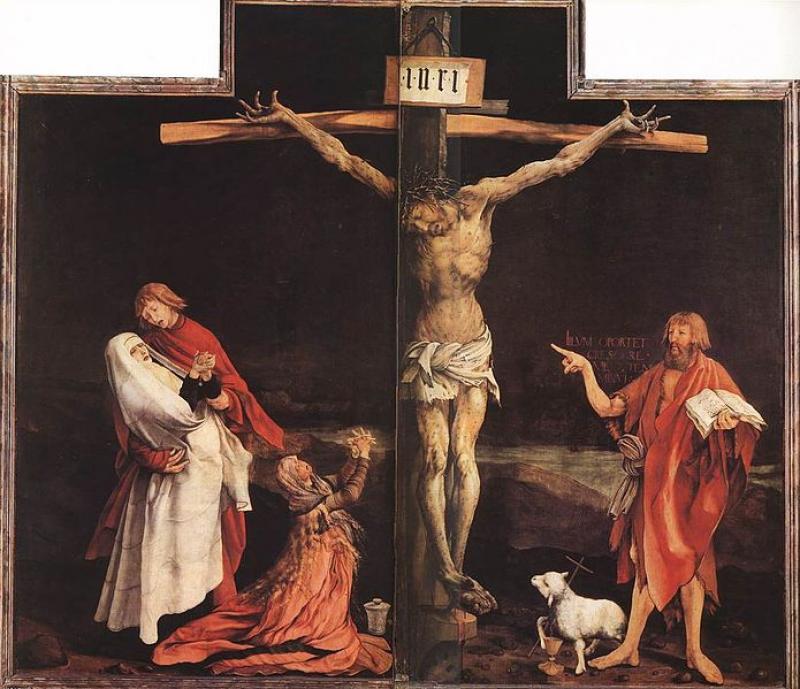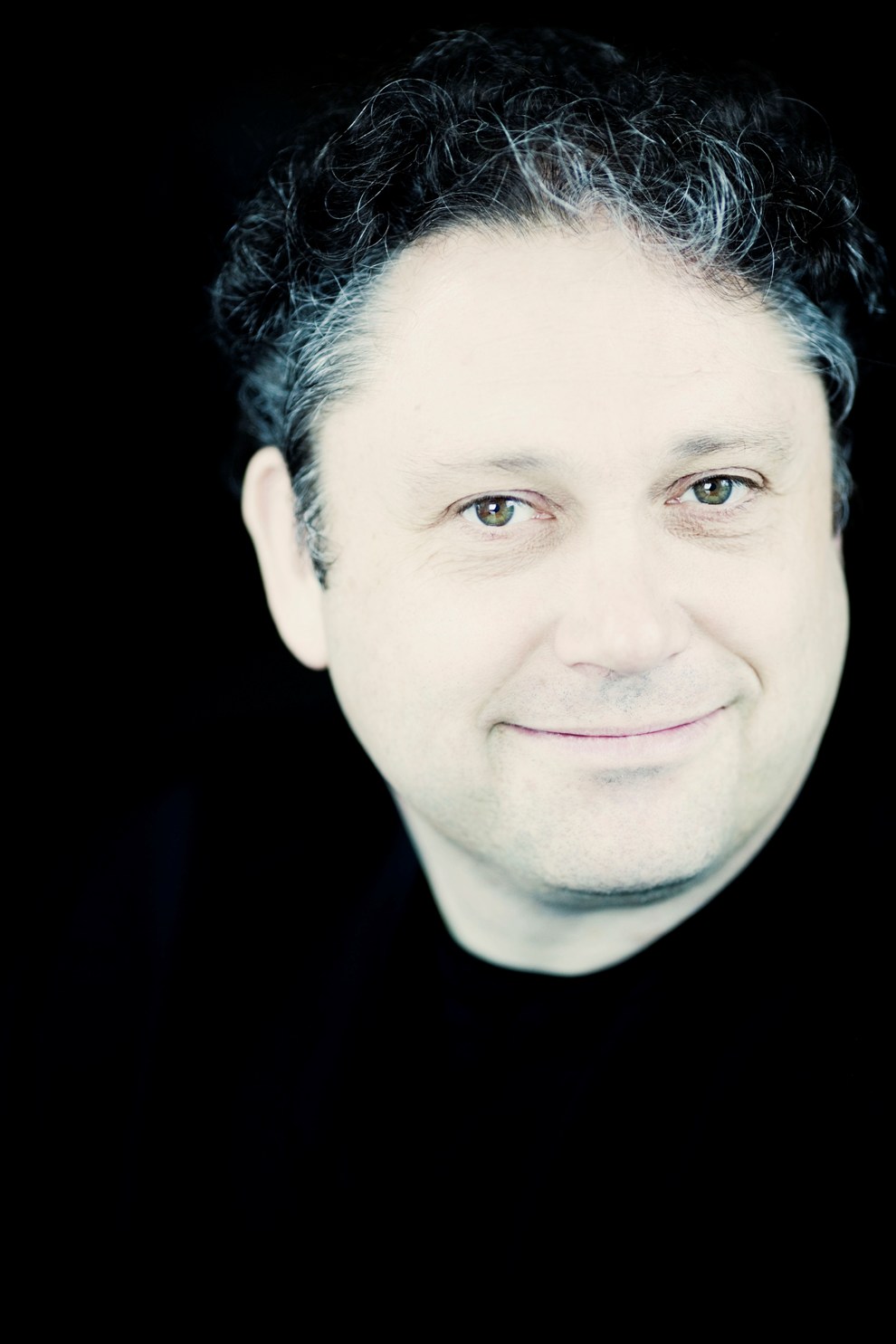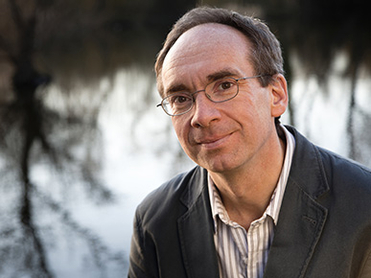Bach St John Passion, Academy of Ancient Music, Egarr, Barbican Hall | reviews, news & interviews
Bach St John Passion, Academy of Ancient Music, Egarr, Barbican Hall
Bach St John Passion, Academy of Ancient Music, Egarr, Barbican Hall
World-class soloists lead an operatic take on the Passion that changed the musical world

A Leipzig church is surely the place we’d most like to be for Bach on Good Friday. Never mind: the Barbican Hall is kinder to the best period instrument ensembles than it is to big symphony orchestras. Better still, having sat stunned and weepy for a good few minutes at the end of this performance, I’m happy to evangelise and proclaim that no better team could be assembled anywhere for the original 1724 version of this world-changing musical Passion.
Richard Egarr (pictured below by Marco Borggreve), directing from the harpsichord, no doubt deserves the credit for the line that passed, without overdrive, through Bach’s most electrifying narrative. What a difference, though, a perfect line-up of soloists makes: a St John Passion that flows like a river without rocks in the middle is a rarity. James Gilchrist’s Evangelist, the platonic ideal of fiery indignation tempered with humble compassion, must surely have raised the game of the four aria singers, Matthew Rose’s true-bass Christ and even newcomer Ashley Riches’s nuanced characterization of Pilate.
 Expressive urgency passed like a beacon between the artists, creating two sequences of especially riveting drama. You’d have thought Gilchrist’s peerless handling of the way Bach illustrates the bitter tears of thrice-denying Peter would cast the tenor to follow in the shade (Gilchrist pictured below). Not at all: Andrew Kennedy kept the tension crackling in the 1724 aria “Ach, mein Sinn, wo willst du endlich hin”. An exciting hurtle towards a top note or two even recalled the dangerous edge in Peter Anders’s wartime recording of Schubert’s Winterreise.
Expressive urgency passed like a beacon between the artists, creating two sequences of especially riveting drama. You’d have thought Gilchrist’s peerless handling of the way Bach illustrates the bitter tears of thrice-denying Peter would cast the tenor to follow in the shade (Gilchrist pictured below). Not at all: Andrew Kennedy kept the tension crackling in the 1724 aria “Ach, mein Sinn, wo willst du endlich hin”. An exciting hurtle towards a top note or two even recalled the dangerous edge in Peter Anders’s wartime recording of Schubert’s Winterreise.
With the energy levels unsapped thanks to a short retuning break rather than an interval, Part Two held us at the same level. And then came the daring silences, ushered in with the release of the great alto aria “Es ist vollbracht”. It was projected unforgettably with the now-familiar poised anguish and monumental triumph only Sarah Connolly can convey in equal measure, rendered more intimate still by equal partner Reiko Ichise’s hypersentitive viola da gamba playing.
 What followed remained on the same exalted plane. There was the charismatic joy of Christopher Purves, now in full gear following the remains of the infection that seemed to have been plaguing him in the penultimate performance I saw of Written on Skin, bouncing a complementary chorale into discreet action. After a further brief bout of aching arioso from Kennedy, there was also the searing dynamic range of that wonderful soprano Elizabeth Watts in “Zerfließe, mein Herz”, AAM woodwind in plangent tow.
What followed remained on the same exalted plane. There was the charismatic joy of Christopher Purves, now in full gear following the remains of the infection that seemed to have been plaguing him in the penultimate performance I saw of Written on Skin, bouncing a complementary chorale into discreet action. After a further brief bout of aching arioso from Kennedy, there was also the searing dynamic range of that wonderful soprano Elizabeth Watts in “Zerfließe, mein Herz”, AAM woodwind in plangent tow.
Within the drama proper, the Academy’s youthful chorus seemed to be aiming for agility rather than the feral quality that can animate the propulsive crowd numbers; but you couldn’t fault the shapely, word-sensitive phrasing Egarr drew from them in the chorales. The subtle touches he brought to his harpsichord continuo line – an after-twang, for example, to illustrate the crown of thorns – were echoed by his superb orchestral players; from the knife-thrust of the oboes’ semitonal clashes in the opening, you could tell this was going to be music-theatre on a metaphysical level. All Good Friday boxes sublimely ticked, then: pity, terror, consolation, even a dash of anticipatory joy. The fireworks of Easter can only seem tawdry by comparison.
rating
Share this article
Add comment
The future of Arts Journalism
You can stop theartsdesk.com closing!
We urgently need financing to survive. Our fundraising drive has thus far raised £49,000 but we need to reach £100,000 or we will be forced to close. Please contribute here: https://gofund.me/c3f6033d
And if you can forward this information to anyone who might assist, we’d be grateful.

Subscribe to theartsdesk.com
Thank you for continuing to read our work on theartsdesk.com. For unlimited access to every article in its entirety, including our archive of more than 15,000 pieces, we're asking for £5 per month or £40 per year. We feel it's a very good deal, and hope you do too.
To take a subscription now simply click here.
And if you're looking for that extra gift for a friend or family member, why not treat them to a theartsdesk.com gift subscription?
more Classical music
 Hallé John Adams festival, Bridgewater Hall / RNCM, Manchester review - standing ovations for today's music
From 1980 to 2025 with the West Coast’s pied piper and his eager following
Hallé John Adams festival, Bridgewater Hall / RNCM, Manchester review - standing ovations for today's music
From 1980 to 2025 with the West Coast’s pied piper and his eager following
 Kaploukhii, Greenwich Chamber Orchestra, Cutts, St James's Piccadilly review - promising young pianist
A robust and assertive Beethoven concerto suggests a player to follow
Kaploukhii, Greenwich Chamber Orchestra, Cutts, St James's Piccadilly review - promising young pianist
A robust and assertive Beethoven concerto suggests a player to follow
 Robin Holloway: Music's Odyssey review - lessons in composition
Broad and idiosyncratic survey of classical music is insightful but slightly indigestible
Robin Holloway: Music's Odyssey review - lessons in composition
Broad and idiosyncratic survey of classical music is insightful but slightly indigestible
 Classical CDs: Wolf-pelts, clowns and social realism
British ballet scores, 19th century cello works and contemporary piano etudes
Classical CDs: Wolf-pelts, clowns and social realism
British ballet scores, 19th century cello works and contemporary piano etudes
 Bizet in 150th anniversary year: rich and rare French offerings from Palazzetto Bru Zane
Specialists in French romantic music unveil a treasure trove both live and on disc
Bizet in 150th anniversary year: rich and rare French offerings from Palazzetto Bru Zane
Specialists in French romantic music unveil a treasure trove both live and on disc
 Scottish Chamber Orchestra, Ibragimova, Queen’s Hall, Edinburgh review - rarities, novelties and drumrolls
A pity the SCO didn't pick a better showcase for a shining guest artist
Scottish Chamber Orchestra, Ibragimova, Queen’s Hall, Edinburgh review - rarities, novelties and drumrolls
A pity the SCO didn't pick a better showcase for a shining guest artist
 Kilsby, Parkes, Sinfonia of London, Wilson, Barbican review - string things zing and sing in expert hands
British masterpieces for strings plus other-worldly tenor and horn - and a muscular rarity
Kilsby, Parkes, Sinfonia of London, Wilson, Barbican review - string things zing and sing in expert hands
British masterpieces for strings plus other-worldly tenor and horn - and a muscular rarity
 From Historical to Hip-Hop, Classically Black Music Festival, Kings Place review - a cluster of impressive stars for the future
From quasi-Mozartian elegance to the gritty humour of a kitchen inspection
From Historical to Hip-Hop, Classically Black Music Festival, Kings Place review - a cluster of impressive stars for the future
From quasi-Mozartian elegance to the gritty humour of a kitchen inspection
 Shibe, LSO, Adès, Barbican review - gaudy and glorious new music alongside serene Sibelius
Adès’s passion makes persuasive case for the music he loves, both new and old
Shibe, LSO, Adès, Barbican review - gaudy and glorious new music alongside serene Sibelius
Adès’s passion makes persuasive case for the music he loves, both new and old
 Anja Mittermüller, Richard Fu, Wigmore Hall review - a glorious hall debut
The Austrian mezzo shines - at the age of 22
Anja Mittermüller, Richard Fu, Wigmore Hall review - a glorious hall debut
The Austrian mezzo shines - at the age of 22
 First Person: clarinettist Oliver Pashley on the new horizons of The Hermes Experiment's latest album
Compositions by members of this unusual quartet feature for the first time
First Person: clarinettist Oliver Pashley on the new horizons of The Hermes Experiment's latest album
Compositions by members of this unusual quartet feature for the first time

Comments
"The subtle touches he